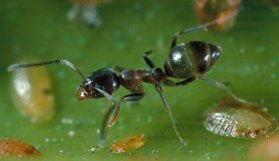Ant invasions change the rules
Ant invaders may wreck the rules by which entire communities of their peers work.
Share this:
- Share via email (Opens in new window) Email
- Click to share on Facebook (Opens in new window) Facebook
- Click to share on X (Opens in new window) X
- Click to share on Pinterest (Opens in new window) Pinterest
- Click to share on Reddit (Opens in new window) Reddit
- Share to Google Classroom (Opens in new window) Google Classroom
- Click to print (Opens in new window) Print
By Emily Sohn
Ants can ruin picnics and drive cooks out of kitchens. The tiny invaders may also wreck the rules by which entire communities of their peers work, new research suggests.
Argentine ants are native to South America, but they now live in warm places on six continents and have spread to 21 states in the United States.
 |
|
Argentine ant.
|
| Stanford Univ. |
In 1993, Nathan Sanders of Humboldt State University in Arcata, Calif., saw that the ants were moving north through California. Curious to see if the little critters were affecting other ants as they moved, he decided to do a little experiment.
Sanders and his coworkers went to nearby Jasper Ridge Biological Preserve before the South American ants arrived. The researchers found some 20 species of ants living there. Different species rarely interacted with each other.
But after the Argentine ants showed up, everything changed. Suddenly, native ants in the preserve were more scattered and much more likely to live in contact with other native species. Seven years of data suggest the changeover happened fast.
Sanders thinks that the invaders changed all the rules that native ants normally live by to make them behave in new ways. Other ecologists aren’t yet convinced.
At least we’re still safe, however. Ants can destroy our picnics, but, for now, they’ve left our communities intact.







